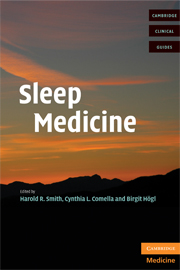1 - Normal sleep
from SECTION 1 - NORMAL SLEEP
Published online by Cambridge University Press: 08 August 2009
Summary
Introduction
The state of wakefulness regularly alternates with the states of sleep. Our initial knowledge of the states of sleep was based on observations of individual subjects while asleep. The beginning of the scientific era of research in normal humans dates back to the sleep deprivation studies conducted by Kleitman in the 1920s. In the following decade, the first classification of sleep stages was published by Loomis et al. in 1937, and Kleitman's comprehensive landmark monograph Sleep and Wakefulness was published in 1939. Loomis's classification was based on electroencephalographic (EEG) criteria alone and distinguished five different sleep states, from wakefulness (A) to deep sleep (E). In 1953, Aserinsky and Kleitman described a special type of sleep with rapid eye movements, and sleep was subsequently classified based on EEG and electrooculographic (EOG) parameters. This classification system distinguished four stages of sleep without rapid eye movements (NREM sleep) and a state of sleep with rapid eye movements (REM sleep). Following the discovery of muscle atonia accompanying REM sleep by Jouvet in 1962, a revised classification of sleep was developed using the three parameters of EEG, EOG, and electromyography (EMG). In 1968 this staging system was published in the Manual of Standardized Terminology, Techniques, and Scoring System for Sleep Stages of Human Subjects, under the leadership of Rechtschaffen and Kales, and is still used worldwide.
Polysomnography
Polysomnography (PSG) is the recording of several electrophysiologic signals during sleep. Polysomnography uses the 10–20 international electrode placement system for EEG recording (Fig. 1.1).
- Type
- Chapter
- Information
- Sleep Medicine , pp. 9 - 24Publisher: Cambridge University PressPrint publication year: 2008



